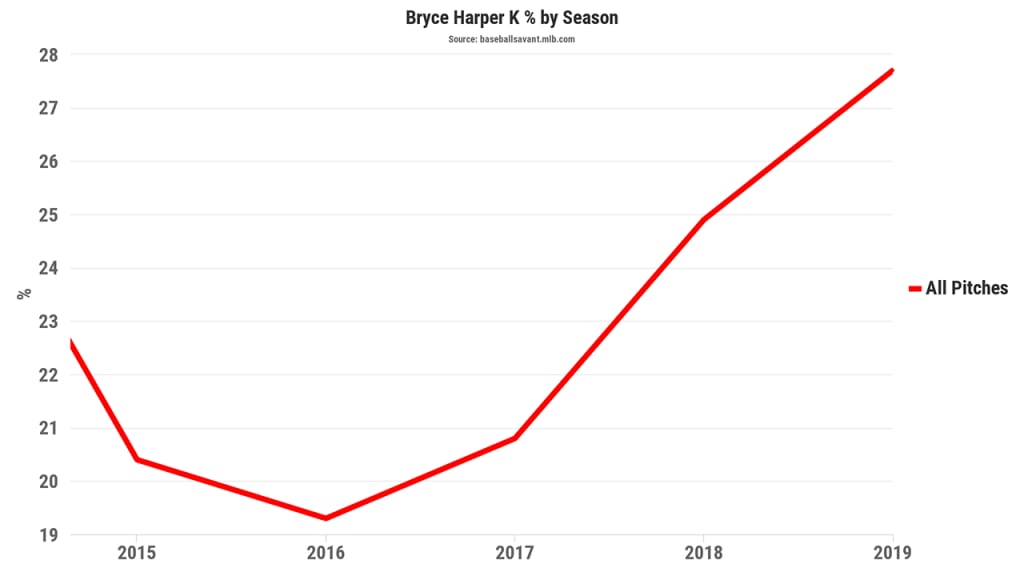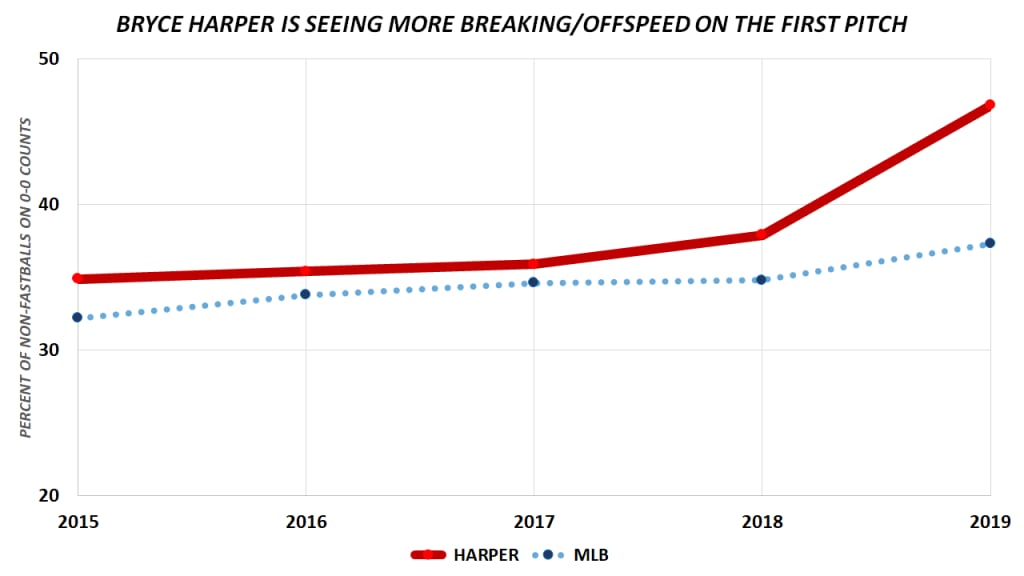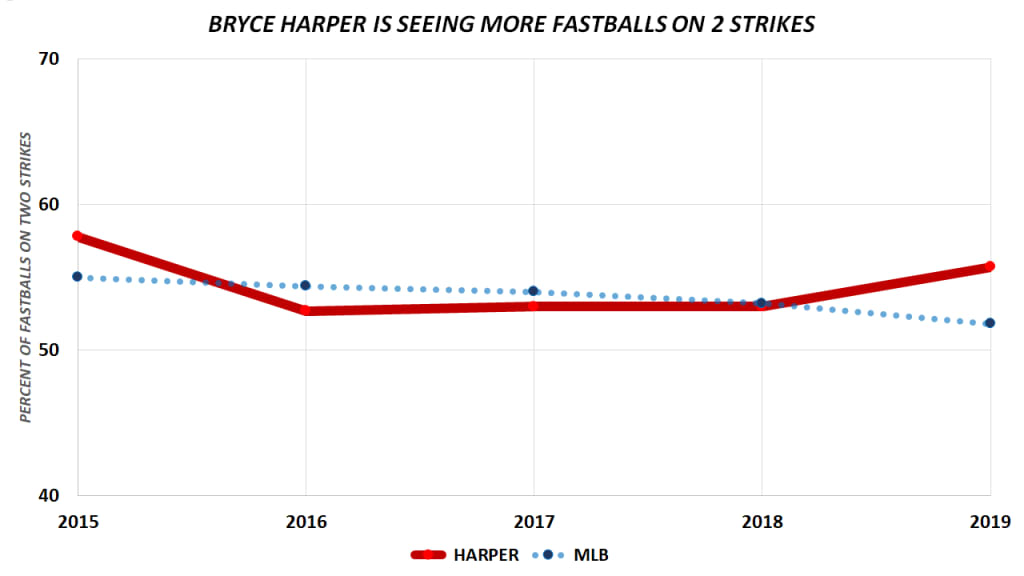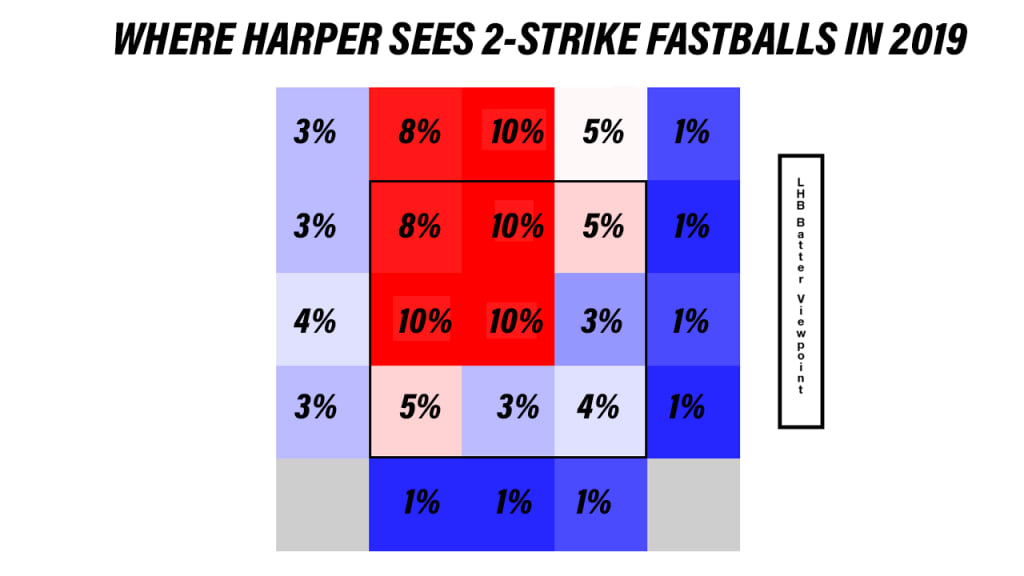When Bryce Harper makes contact with the ball, things are going great.
Better than great, actually, because he's hitting it just as well as he did during his historically great 2015 MVP season. His 47.5% hard-hit rate is a career best, a Top 25 mark higher than Pete Alonso or J.D. Martinez. His barrel rate -- barrels being the perfect combo of exit velocity and launch angle -- is a career-best 13.4%, better than Cody Bellinger or Dan Vogelbach.
When Harper makes contact with the ball, he's mashing it, better than he did last year, or the year before, or pretty much in any year. If you look at exit velocity on fly balls and line drives, the area where it really matters, his 98.4 MPH is better than anyone who has hit 100 of them, ahead of Christian Yelich and Alonso. His ground ball rate has remained steady. His 30.5% line drive rate is the highest it's been since that MVP 2015; his pop-up rate is a five-year low. These are good signs. These are great signs. You can see them in the monstrous homers he still hits.
But the phrase "when Harper makes contact with the ball" is doing a lot of work there, isn't it? Harper's first season in Philadelphia (.246/.363/.465, 113 OPS+) isn't going nearly as well as that magical 2015 did (.330/.460/.649, 198 OPS+), obviously, and it's not terribly hard to see why: Even in a baseball world where strikeouts don't matter nearly as much as they once did, Harper's strikeout problem is becoming a massive concern.
Three years ago, Harper's 18.7% strikeout rate was the 74th highest of 146 qualified hitters. This year, his 27.8% rate is the 17th highest of 162 qualified hitters. It's a problem. It's the problem -- and it appears that teams have figured out how to attack a hole he's been unable to close.

If Harper is striking out more, where are those whiffs coming from? It's not just that he's riding the same wave that's caused record-setting strikeout totals in the Majors every year for many years. It's got to be something more specific. It's got to be about something opponents think they can do in order to make Harper vulnerable. When you've still got lightning in your bat, after all, the best thing you can do as a pitcher is to try to make sure you avoid as much contact as possible.
Here's the four-step plan opponents are working from in order to keep Harper down.
1) No more crushable first-pitch fastballs.
Harper has hit 198 home runs in his career, and the count with the largest number of them (45, or nearly 23%) is the first pitch. (The Major League average since his 2012 debut: 17%.)
Of those 45 first-pitch homers, 29 of them, or nearly two-thirds, have come on fastballs. Harper's career slugging percentage on first-pitch fastballs is .731; his slugging percentage on fastballs in all other counts is .552. He loves to jump on a hittable first pitch.
Solution: No more -- well, fewer, anyway -- first-pitch fastballs! Harper is now seeing breaking or offspeed stuff on the first pitch nearly half the time, up from just under 35% of the time two years ago. That trend has been true across the Majors as well, but slowly, and Harper's jump from 37% to 47% is massive.

Of Harper's 14 homers this year, only three have come on the first pitch.
2) Before two strikes, more breaking and off-speed pitches.
In fact, why stop there? It's most notable on the first pitch, but Harper is seeing fewer fastballs before he gets to two strikes than ever, even above and beyond the trends across the game.
Put another way, in 2017, Harper saw 489 non-fastball pitches before two strikes. He's already up to 438 this year. That was only two years ago.

They're doing this because it's successful. When Harper took a swing at a breaking/off-speed pitch before two strikes in 2015, he missed 34.2% of the time. Last year, that was 39.5%. This year, it's up to a career-high 44.9%.
That's a higher rate than what he's done on fastballs, and that's the point. While his 29.5% miss rate on fastball swings before two strikes is higher than it was two years ago (20.3%), it's about the same as it was in 2015 (24.1%), and either way, all of those numbers are far less than what he does on non-fastballs.
3) On two strikes, here come the fastballs ...
So you've managed to get Harper to two strikes. The regularity of this hasn't really changed, for what it's worth; Harper sees 29% of his pitches on two strikes, and his career mark is 28.3%. Nothing to see here.

4) ... and especially more high fastballs.
Here's the key, really. When Harper gets those two-strike fastballs, look where they arrive.

The chart makes it clear: High and outside. That's not an accident. In 2019, no hitter has offered and missed at more two-strike high-and-outside fastballs. In 2018, no hitter offered and missed at more two-strike high-and-outside-fastballs. This is it. This is the hole, perhaps exacerbated by all of the lower breaking stuff earlier in the count that changes his eye level.
This is what Miami's José Ureña knew.
And it's what Milwaukee's Jhoulys Chacín knew, too.
Because: look what's happening. Each year, the two-strike fastballs get higher, if we look at the rate of "high fastballs" Harper is seeing. (A "high fastball" being considered one above 2.5 feet above the ground.)
2015: 60.7%
2016: 48.7%
2017: 59.6%
2018: 60.8%
2019: 63.9%
Each year, Harper misses at more of the two-strike fastballs he swings at.
2015: 20.3%
2016: 20.2%
2017: 21.7%
2018: 23.9%
2019: 29.5%
And, while this trend isn't quite as linear, you can see just how much slugging percentage Harper has lost on two-strike fastballs.
2015: .466
2016: .405
2017: .652
2018: .369
2019: .279
This is the plan, and opponents are working it to a tee. On those high-and-away two-strike fastballs, Harper is slugging just .222 this year, with three extra base hits.
But what's next? There's a lot of talk about Harper needing to slow down, or not trying to overextend. “It’s the lowest effort level that we’ve seen from him all year," Phillies hitting coach John Mallee told MLB.com approvingly after a brief end-of-May hot streak. "He's a little bit more relaxed," manager Gabe Kapler told the Washington Post earlier this month.
If so, it's true that Harper has done a very nice job of cutting down his strikeout problem this month. In April, Harper whiffed 29.5% of the time. In May, that was 31.4%. In June, that's down all the way to 21.2%, a huge drop. Normally, that would be a great sign... if not for the fact that his slugging percentage has dropped from .490 to .472 to .398 over the three months, too.
It might take some aggression to get to that prodigious power. It's going to take beating the opponents at their own game. Harper is still a valuable player, because he's improved his jumps in the outfield and his play along with it, and he's still been a hitter 12 percent better than average, which puts him on track for something like a 4 WAR season, roughly All-Star level.
The Phillies have talked about being more aggressive on fastballs recently, in an attempt to cure some team-wide hitting woes. Harper's got his own fastball issues. More importantly, teams are learning how to exploit them.


